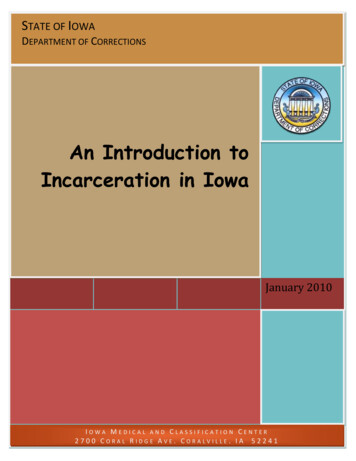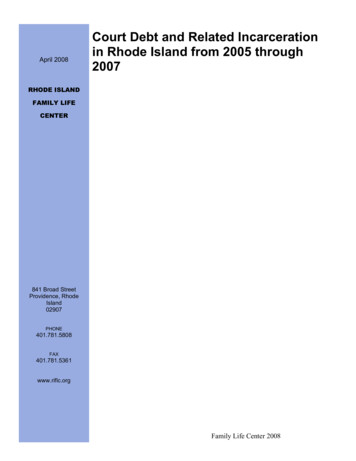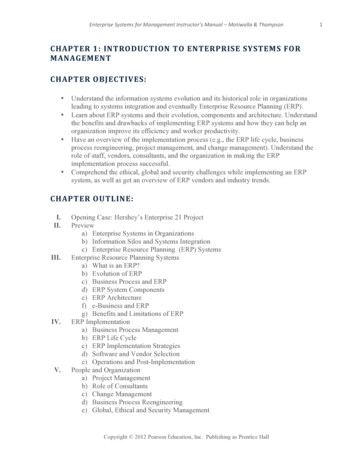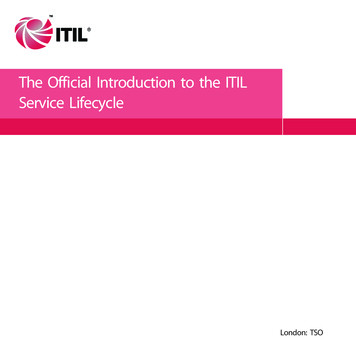
Transcription
STATE OF IOWADEPARTMENT OF CORRECTIONSAn Introduction toIncarceration in IowaJanuary 2010IOWA MEDICAL AND CLASSIFICATION CENTER2700 CORAL RIDGE AVE. CORALVILLE, IA 52241
Why Did We Develop This Book?The Department of Corrections staff realizes that you may havemany questions and concerns as you enter the system. We adhere tobest practices in corrections. We realize family and social supportsare also very important factors in leading to success. Therefore, wecreated this guidebook to provide an overview of the incarcerationprocess and answer some frequently asked questions.Introduction to IncarcerationPage 2
ContentsWhy Did We Develop This Book? . 2Introduction . 4Mission of the Iowa Department of Corrections . 4Organization of the Department of Corrections . 4Before you get to Prison . 5The Reception Process . 5Classification . 5Offender Programs . 7Communications . 9Visitation . 9Offender Conduct Rules and Disciplinary Procedures . 10Searches. 10Offender Access to the Courts . 10Health Care Services . 10Mental Health Services . 11Food Services . 11Other Information Related to the Offender’s Stay . 11Introduction to IncarcerationPage 3
IntroductionSeparation from a loved one due to incarceration can be emotionally, spiritually, andeconomically overwhelming.This guidebook has been developed for you as a resource in understanding the rulesand regulations that govern the Iowa institutions. Although this guidebook may notanswer all of your questions, it is intended to provide general information about theIowa system.Please take the time to read this information carefully. It is important to know thatthis guidebook is for informational purposes only, and the regulations outlinedherein are subject to change. It is important to remember that if changes occur inthe Department of Correction’s policies and procedures, institutional rules, and instate laws, those changes override this guidebook.Mission of the Iowa Department of CorrectionsThe mission of the Iowa Department of Corrections is to: Advance successfuloffender reentry to protect the public, staff and offenders from victimization.Organization of the Department of CorrectionsThe Department of Corrections (DOC) is a state government agency which is part ofthe Executive branch and is headed by the Director of Corrections, a cabinet officerappointed by the Governor. The Department of Corrections consists of nineinstitutions located throughout the state and the DOC Central Office Headquarterslocated in Des Moines, Iowa. Community-based correctional services such asprobation, parole, and work release are provided through contracts between the DOCand the Judicial Districts; however, the focus of this booklet is to provide informationabout the Iowa institutional system, not community-based corrections.The DOC is organized into two geographic regions: Western and Eastern. A regionaldeputy director oversees each region. A warden or superintendent providesleadership at each institution and reports to the regional deputy director.The Board of Parole is not a division of the DOC. It is an independent body whosemembers are appointed by the Governor. The Parole Board is the releasing authorityfor offenders in the DOC.Introduction to IncarcerationPage 4
Before you get to PrisonYou are allowed to bring only a few personal items with you to prison they are asfollows:A bible, address book, a small amount of photos, and any cash that you haveanything else, have your people come and get or discard it in the county jail beforeyou get to IMCC this will help speed up the intake process.The Reception ProcessWhat happens when you first enter the Department of Corrections?All offenders arrive at the Iowa Medical and Classification Center in Coralville, Iowa.This institution is the reception center for the Iowa DOC. The reception process willlast about four to six weeks. Counseling staff are available to assist you in making anadequate adjustment to the institution.During the reception process, staff will gather information about family history,educational background, work history, medical history, and criminal history. Medical,dental, and mental health screening is completed during this time you will be testedand interviewed to determine individual needs and appropriate institutionalplacement.You will be involved in an orientation process and receive information which explainsrules, penalties, disciplinary procedures, how to obtain health services, and otherimportant information.Your case will be reviewed and a decision will be made based on the informationgathered as to which institution you will be transferred to upon leaving the IowaMedical and Classification Center.ClassificationThe purpose of the classification process is to assign you to an institution that canbest meet your educational, vocational, physical health, mental health, and othertreatment needs. Additionally, classification is necessary to ensure the safety of thegeneral public and the needs of the Department.How is it determined where you will be housed?You will be classified based on conduct, types of criminal offenses, sentence length,and other factors. Classifications are reviewed periodically. Some of the many factorsconsidered during classification reviews include your current and past criminalbehavior, your adjustment to the institutional setting including institutional behavior,Introduction to IncarcerationPage 5
escapes, and other rule violations, current age, and amount of time served versustime remaining to be served.What is custody classification and what are the custody levels?Custody classification refers to you being placed into a custody level. Each institutionis operated on one or more custody levels. Those custody levels are minimum,medium, and maximum.Minimum Custody – This custody is the least restrictive and has the most privilegesof the custody grades. Offenders in this level may work on the grounds away from theunit or away from the institution with appropriate supervision.Medium Custody – This custody is more restrictive than minimum custody.Offenders are generally restricted to working within the boundaries of the institutionand are usually assigned to dormitory or cell setting in medium custody.Maximum Custody – This custody is more restrictive than medium custody. It is forthose who may be an escape risk or have been convicted of violent crimes, or theiractions in institutional setting have shown they may be a behavior problem. Maximumcustody housing is generally made up of single cells and divided into cellblocks,within a building or unit. Offenders in this custody are also under constantsupervision.All offenders undergo routine custody reviews. Their current custody is reviewed todetermine if the offender is appropriately assigned to the institution. Progression to aless restrictive custody grade is a privilege granted to offenders. It is awarded byobeying rules and meeting other mandatory requirements. Other factors are alsotaken into consideration including pending charges, physical and mental healthneeds, risk to the community, risk to other offenders and staff, number and nature ofinfractions, and time since last infraction.Are there other types of classification or housing assignments?Most offenders are assigned to general population. This means you may move aboutthe institution as needed due to job or program assignment, for recreation, andmealtime. In addition to the various custody levels, offenders may also be assignedto a segregation status, where offenders are separated from the regular population.All segregation is used to manage behavior.These assignments include:Administrative Segregation – The classification status that temporarily removes anoffender from the population and places them in a single cell on a short-term basis toprotect staff and other offenders, preserve order, provide control or protection of theIntroduction to IncarcerationPage 6
offender pending final classification or disciplinary action.Disciplinary Detention –Disciplinary Detention is a determined number of days anoffender is in segregation as the result of being found guilty in a hearing of a Majordisciplinary report.Protective Custody – A classification status in which an offender is separated fromthe regular population because the offender’s safety or well-being is perceived to beat risk or for which there may be concern for a variety for reasons. An offender mayrequest protective custody, but a committee decides if protective custody isnecessary.Offender ProgramsWhat programs are available to offenders?Programs provide the opportunity for offenders to play an important role in promotingpersonal growth and learning more responsible behavior which may eventually helpthem to become contributing members of the community. Activities are also animportant part of the mission and philosophy of the Department of Corrections.Programs vary at each institution and may not be immediately available.The following is a brief description of the programs.Case Management – Case management is a program of services provided to eachoffender in the Department of Corrections. Every offender is assigned a Counselor.The Counselor works with the offender to help determine his or her needs, risks, andinterests. Case management provides the services and resources deemednecessary to improve each offender’s likelihood of success by promoting law-abidingbehavior.Work Assignments –Each institution has a variety of jobs for which offenders mayapply for and work. Each institution depends on the offenders to assist in the kitchen,provide housekeeping, and other services to maintain the institution and supportother governmental agencies. Requiring offenders to work is an important effort toteach good work habits and encourage offenders to work when they return to society.Education –Programs are offered for offenders to work on their literacy skills, theirGED, and/or to learn a vocational skill in a wide variety of areas. Special programsare available to offenders with learning disabilities or special needs. Some programsare required and some are provided as an incentive to learn. The DOC partners withthe Community Colleges in Iowa to provide these educational programs. Literacyclasses, high school diploma and sometimes college coursework can beaccommodated. Information about educational opportunities is provided to offendersIntroduction to IncarcerationPage 7
during the orientation process.Religious Services – The DOC authorizes religious practices for all major religions.Organized worship services are provided for many faith groups. The Department ofCorrections employs chaplains at many institutions. The Chaplain’s role is to assistand encourage offenders in spiritual matters and provide spiritual counseling.Chaplains, along with religious volunteers from the community, provide Bible study,worship services, religious training, and ministry to the offenders. The DOC has anestablished policy on what religious items offenders can have in their possession.There is a review and approval process to follow if an offender is practicing a nonscheduled or new religious accommodation requested.Parenting Programs – A number of classes are offered that assist offenders inbeing better parents by helping them to recognize the needs of their children andtheir responsibilities to them. These programs help offenders work to maintain andimprove relationships with their children and family during this difficult time and upontheir release.Reentry Case Planning – Refers to planning for an offender’s release back to thecommunity. It is very important to his or her success that the offender learn newskills and develop good habits to be law-abiding. Planning for release needs to beginwhen the offender enters the system through proper assessment and programmingto meet the needs. Such programs may assist offenders in planning how to findemployment, housing or transportation, continuing in their addiction recovery,furthering their education, and seeking available resources in the community. Familyand friends can assist and provide support and encouragement for them to succeed.If the offender will be under continued supervision such as parole, friends and familycan assist by communicating with the supervising parole officer. If the offender willbe living at your residence, you can ensure the home maintains compliance withrelease criteria guidelines for community-based home placement.Alcoholics Anonymous (AA) and Narcotics Anonymous (NA) – These arevoluntary programs that occur in many of the institutions. It is up to the offenderwhether or not to participate in AA or NA but he or she is encouraged to attend tohelp provide support in their recovery.Recreation, Arts and Crafts – Offenders are provided the opportunity to participate inconstructive recreational and leisure time activities. Some of the activities in whichoffenders may participate include those aimed at improving mental outlook, physicalconditioning, cultural experiences, competitions and special events. These activitiesare usually offered after work duties are completed.Introduction to IncarcerationPage 8
Substance Abuse Treatment Programs – An assessment for substance abusemay be completed as part of the reception process. If treatment is needed, variouslevels of treatment are provided at different institutions throughout the state rangingfrom licensed inpatient treatment to aftercare.CommunicationsCan offenders use the telephone?Yes. You are allowed to make telephone calls. These calls are automatically limitedto 20 minutes by the Offender Pre-Paid Telephone Service. The DOC OffenderTelephone Accounts Pre-paid form must be completed and sent in with each depositto be placed on an offenders telephone account. This form is available at allinstitutions and on the Departments web site at www.doc.state.ia.us. Only cashier’schecks or money orders will be accepted. The minimum deposit is 20.00. Depositswill not be accepted prior to your arrival in the DOC and must be designated to you.They must be identified by your name and matching DOC I.D. number. Deposits mayalso be designated to a specific telephone number as well. Toll free numbers and900 numbers are prohibited.All deposits must be mailed directly to:IDOCOffender Telephone AccountsPO Box 1417Fort Madison IA 52627Can an offender send and receive mail?Yes. One of the most important ways to communicate with the offender is throughletters. The DOC encourages family and friends to write. For security reasons, allincoming and outgoing mail will be checked to see if it contains any illegal orunauthorized items. Legal mail is opened by you in the presence of staff. Offenderswho have no money may be eligible to receive two free stamped envelopes perweek. Send letters to:Iowa Medical and Classification CenterC/o OFENDER NAME AND NUMBER2700 Coral Ridge Ave.Coralville, Iowa 52241VisitationVisitation by family and friends is encouraged and can make a positive differenceduring your incarceration. The Department of Corrections understands theimportance of maintaining contact with family and friends. However, you are notIntroduction to IncarcerationPage 9
assigned to specific locations for the convenience of visitation.Visitation rules have been established to ensure the safety of visitors, offenders, andstaff. These rules are listed on the visitor application and posted in areas accessibleto visitors. Visitation rules are also available on the Iowa DOC website df. It is important to rememberthat visitation is a privilege which can be restricted for offenders and visitors whoviolate the rules.Offender Conduct Rules and Disciplinary ProceduresRules are established and must be followed. Good behavior of offenders is expectedand necessary to ensure safety and security for both the offenders and staff. Therules, disciplinary procedures, and sanctions can be found in institution offenderhandbooks and rulebooks.There are two types of disciplinary reports that may be issued:1.) A Class II (minor) report – for minor infractions2.) A Class I (major) report – for more serious infractionsSearchesOffenders are subject to a search at any time. Searches may be done at random orplanned. Routine searches, also called “pat down” searches, maybe done by maleand female staff, and are normally done while you are fully dressed. Completesearches are called “strip searches,” where you are required to remove your clothingso as to include a visual search of the body. “Area searches” are searches of livingquarters, work areas, recreational areas, visiting areas, etc. and may be done at anytime. Offenders who, in any way, interfere with or fail to cooperate fully with staff aresubject to disciplinary action.Offender Access to the CourtsOffenders confined to the Iowa Department of Corrections are provided access to theCourts and its attendant administrators, clerks, judges, attorneys, andOmbudspersons for the purpose of safeguarding their statutory and constitutionallymandated rights pursuant to IDOC policy (IO-OR-05).Health Care ServicesThe DOC provides health care services for medical, mental health, and dentalneeds. Initial assessments for each offender are completed at the Iowa Medical andClassification Center (IMCC). Initial medical, mental, and dental treatment areIntroduction to IncarcerationPage 10
offered at no cost to the offender. If you initiate, question, or request the need fortreatment through a Health Service Request, a 3.00 co-pay fee may be assessed.No offender is denied access to health care, timeliness of care, or quality of care dueto the inability to pay.IMCC follows the Center for Disease Control guidelines to protect against thetransmission of infectious disease. IMCC, like any medical care provider, must abideby the guidelines governing your right to confidentiality of your medical records.Offenders are encouraged to complete a release of information form to be sent totheir previous provider(s) for ongoing medical conditions. This can be initiated by theoffender through your case manager/counselor. The signed release gives theprovider your permissi
All offenders arrive at the Iowa Medical and Classification Center in Coralville, Iowa. This institution is the reception center for the Iowa DOC. The reception process will last about four to six weeks. Counseling staff are available to assist











